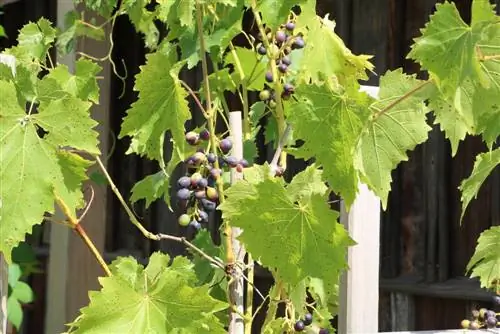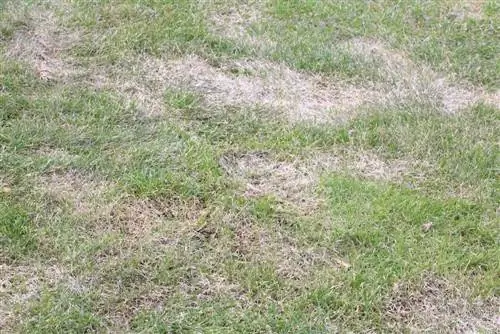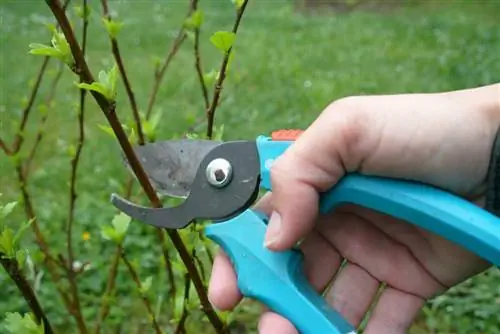- Author admin [email protected].
- Public 2023-12-17 03:39.
- Last modified 2025-01-24 12:45.
Pruning is important for the he alth of the vine and for the subsequent grape harvest, as it must be trained and established in order to deliver a bountiful harvest. Grape vines are extremely tolerant of pruning and do not mind mistakes when pruning, but the roots must not be cut off. In addition, cutting should not be too hesitant; minor cuts are not appropriate here. If vines are not pruned, they grow uncontrollably, go wild quickly and produce only a small number of inferior grapes.
Basics
In German wine-growing regions, grape vines are grown for a rich grape harvest, while hobby gardeners tend to value the decorative value of the vines. Regardless of the motive for cultivation, they need specific pruning so that the appearance and yield are right. The current temperatures must be right for pruning so that no damage occurs. If the climate in the growing region is frostier and the grape variety is extremely sensitive, pruning should be carried out later. In this way, frost damage from the previous winter can be better identified and subsequently corrected. The following aspects should be taken into account when growing and pruning grape vines:
- Grapes belong to the plant family Vitaceae
- Wine is a high-climbing shrub, shoots reach heights of 10 meters and more
- Twigs are colored brown-yellow to reddish-brown
- Flowering period from June to August, with a delicate scent
- Vine produces its flower buds the previous year
- spherical fruits, either sweet or sour flavor
- deciduous leaves are heart-shaped to roundish
- In autumn the foliage shines with brightly colored colors
- frost hardy and perennial plant
- Grape vines need various pruning all year round
- Adapt cutting times to the growth processes
- carry out basic pruning for shaping in the leaf-free period
- ideal times for pruning are late autumn to February-March
- Temperature values must not be below -5 °C when pruning
- frost-free and dry days are ideal
- One-year-old wood is fruit wood, new grapes grow on it
- Perennial or old wood is used for the structure of the hive
Shape
There are various ways to design the vines in terms of shape; this must be adapted to the location conditions and personal wishes. The various forms vary in difficulty in carrying out and are suitable for either beginners or advanced wine growers. The following cutting form is well suited for hobby gardeners:
- The fan trellis is a suitable shape for beginners
- Combination of horizontal and sloping cordon arms, which branch out several times
- Subject education fills a lot of space and has high decorative value
- Do not set the number of legs and branches too high
- maintain sufficient distance, approx. 0.5-1.0 meters
- Trellis helps with the correct shaping of the shoots
Cutting guide
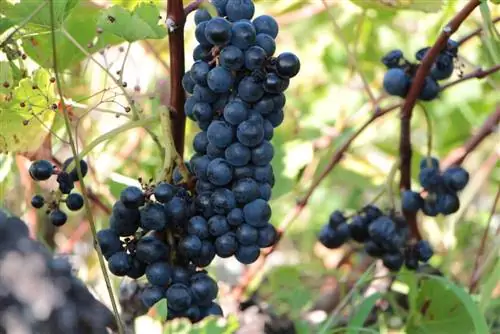
With grapevines, pruning is usually started after the leaves have fallen, although very young vines must first be trained into the correct shape and direction of growth. The following aspects must be taken into account when making the cut:
- just let the vine grow in the first year of life
- train and build up young vines at the beginning, only then prune them
- For new plants, first let a strong shoot grow long and straight
- The main shoot then forms the trunk of the vine
- ideally you can see some kind of trunk structure on the vine
- remove all side shoots from the future main trunk
- Clean and extremely sharp cutting tools are extremely important
- Disinfect and sharpen tools in advance
- Cut the fruit wood as close as possible to the old wood
- leave a small stub of 1-2 cm behind the last bud
- Stub prevents the bud underneath from drying out
- Always cut at an angle
- Do not squeeze or injure shoots unnecessarily when cutting, otherwise they will bleed
In spring
Pruning in early spring promotes a balance between the growth of the vine and subsequent fruit success. This pruning is also called winter pruning and is an important process in the life cycle of a grape vine. With a little preparation and an initially cautious approach, you can quickly achieve initial success with pruning:
- Prune vines in spring from February to March, this is the main annual pruning
- the stronger the pruning, the greater the growth of the cane
- recognize the wood from the previous year, these are all shoots that grew in the previous year
- Previous year's shoots are usually yellow-brown, ocher or red-brown
- last year's shoots have buds 5-15 cm apart; when scratched, they are green on the inside
- Carry out the first rough cut, shorten all thin, previous year's shoots to around 4-6 buds
- locate and mark suitable buds
- approx. 15-20 eyes per square meter should remain on the area
- make a second rough cut, cut off all shoots marked as unsuitable
- Thicker shoots can be cut away up to the main trunk
- With a radical cut, up to 90% of the branches can be removed
- final fine cut of the remaining shoots
- leave stubs with only 2-3 buds in the lower area, so-called cones
- In the upper area there are shoots with 4-6 buds, so-called stretchers
Tip:
After the first rough pruning, count the buds and only select the good ones, these are significantly thicker and are located near a thicker trunk. If these areas are marked with a colored tape, making the cut is easier and more targeted.
In Autumn
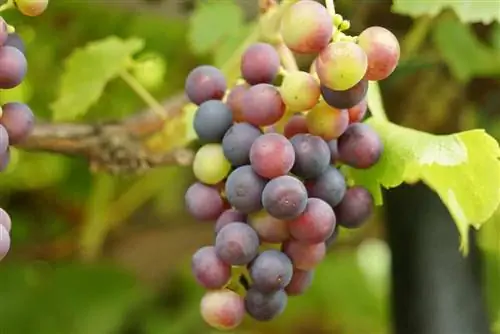
Pruning in autumn is the actual grape harvest, of course only if fruit has formed at all. In addition to harvesting the grapes, the vines can be pruned for aesthetic purposes at this time, especially when longer and stronger growing vines develop into unwanted competing shoots next to the main trunk:
- cut off all ripe grapes in late autumn
- Check ripeness beforehand, some still need a few days of sun
- remove all canes that do not bear grapes
- shorten supporting canes so that a maximum of four leaves remain on the shoot
- also cut off all overhanging shoots that have grown too long
Tip:
If there is an unbalanced ratio between ripe and unripe grapes during the grape harvest period, then the area with the unripe grapes must be defoliated. In this way, the grapes receive more sun to ripen.
Conclusion
Pruning the vines is extremely important and should be carried out annually, but it is easy to handle and the pruning-tolerant plant forgives even major beginner mistakes. If you want not only leaves to grow, but also grapes, then some pruning measures throughout the year are essential. This promotes the he alth and growth of the vine and its grapes; woody and unsightly canes have no chance to develop. It is crucial to choose a forest-free day with a pleasant climate for pruning so that the vines can recover quickly after cutting.
Interesting facts
One way to shape your vine is the fan trellis. This form is well suited for beginners. Because it is easy to handle, fan training of the vine is widespread. It is a combination of horizontal and sloping cordon arms that branch out several times. This fills a lot of space. The number of legs and branches must not be too high. There must be enough distance between them, about 0.5 to 1.0 meters.
- In the first year you simply let the plant grow.
- To plant, cut the vine back to three mature shoots at the end of the second winter.
- This will make the trunk structure loose and not too tight.
- These three shoots are loosely bent apart and attached to climbing aids.
- Winter pruning is done to eight to ten eyes.
- Leave about four buds on each arm for future shoots.
- One or two buds remain at each end for trunk extension.
- Unneeded buds are broken out.
- The shoots for trunk extension are shaped over the summer and attached to the scaffolding.
- All shoots are allowed to keep the grapes.
- In winter, the outer shoots are cut and tied to eight to ten eyes to lengthen the trunk.
- The shoots that are not needed for extension are shortened to short cones with two eyes.
- Only one or two buds per shoot remain on the shoots for trunk extension. The others are broken out.
- If you can't handle pruning the vines, you can also get professional help.
- Nursery stores, vine dealers and perhaps an experienced neighbor are usually happy to help if you get stuck.

